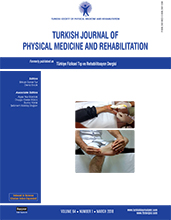Effect of vitamin D levels on radiographic knee osteoarthritis and functional status
Patients and methods: Serum 25(OH)D levels were measured in 107 patients (90 females, 17 males; mean age 63.0±9.6 years; range, 40 to 86 years) with primary knee OA. Radiographic grading was based on the Kellgren-Lawrence Grading Scale and the Osteoarthritis Research Society International (OARSI) Atlas Grading Scale, while the functional status was assessed using the Lequesne indices and Turkish version of the Knee Injury and Osteoarthritis Outcome Score-Physical Function Short-Form (KOOS-PS). Pain was evaluated using the Visual Analog Scale for Pain (VAS-Pain). Data including age, sex, disease duration, body mass index (BMI), and pain severity were recorded.
Results: The mean 25(OH)D level was 13.4±10.6 ng/mL, and 90 patients (84.1%) had vitamin D deficiency. The presence of severe osteophytes was observed in 67 patients (62.6%) and 85 patients (79.4%) had Grade 2-3 joint space narrowing (JSN). The mean KOOS-PS and Lequesne scores were 40.1±12.3 and 12.9±3.6, respectively. There was no correlation between serum 25(OH)D levels and functional status.
Conclusion: Our study results show that serum 25(OH)D level is not related to the severity of the radiographic knee OA grading or to the functional assessment. Age and BMI are the factors affecting the radiological knee OA severity, while age, sex, BMI, and pain severity are the main determinants of the functional status.
Keywords : Functional status; knee osteoarthritis; radiographic grading; vitamin D.

















